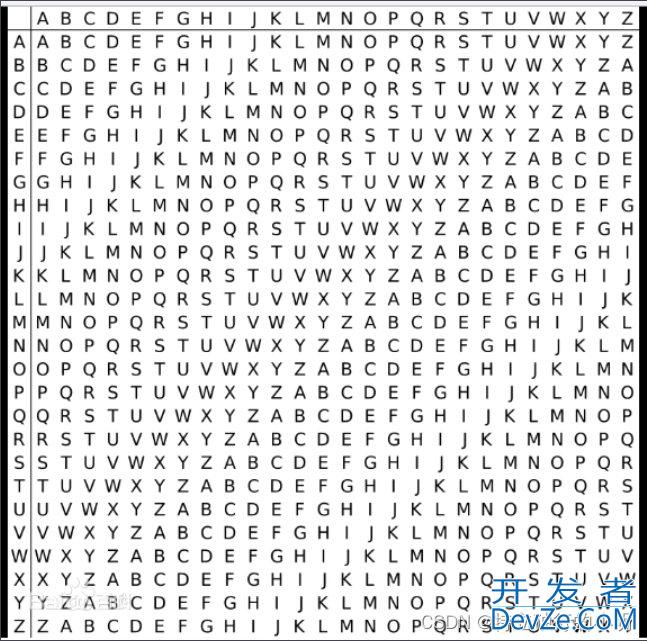C语言实现维吉尼亚密码的示例代码
目录
- 前言
- 一、维吉尼亚(Vigenère)密码原理及介绍
- 二、加密/解密算法介绍
- 1.加密算法
- 2.解密算法
- 三、完整代码展示
- 总结
前言
作业要求:明文中的空格在密文中也有对应空格,明文中的大小写在密文中也有对应大小写。
一、维吉尼亚(Vigenère)密码原理及介绍
在一个凯撒密码中,字母表中的每一字母都会作一定的偏移,例如偏移量为3时,A就转换为了D、B转换为了E……而维吉尼亚密码则是由一些偏移量不同的恺撒密码组成。
在生成密码的时候,可以通过查表的方式(维吉尼亚密码表),通过密钥,来确定明文所对应的密文。

这一表格包括了26行字母表,每一行都由前一行向左偏移一位得到。
例如,假设明文为:
GOODSTUDY
密钥为:
HNUN
由于密钥比明文短,因此需要重复密钥,直至密钥和明文一样长。对于密钥来说,每个字母代表的偏移量为该字母在字母表中的位置
对于第一个字母G,对应密钥第一个字母H,那么由表格中的G行H列加密得到字母N,以此类推,可以得到:
明文:GOODSTUDY 密钥:HNUN 密文:NBIQZGOQF
二、加密/解密算法介绍
1.加密算法
主要思路:通过ASCII码来计算偏移量
附ASCII码对照表:

代码如下:
int Encryption(char* Plaintext, char* key) //加密算法
{
int i = 0, j = strlen(key), k = strlen(Plaintext),m=0;
char result[MAXSIZE] = {0};
for (i = 0; i < k; i++)
{
if (Plaintext[i] != ' '&& Plaintext[i] >= 'a' && Plaintext[i] <= 'z')//明文是小写字母
{
if (key[m % j] >= 'a' && key[m % j] <= 'z')//密钥为小写字母
{
result[i] = (Plaintext[i] + key[m % j] - 2 * 'a') % 26 + 'a';
}
else if (key[m % j] >= 'A' && key[m % j] <= 'Z')//密钥为大写字母
{
result[i] = (Plaintext[i] + key[m % j] - 'A'-'a') % 26 + 'a';
}
m++;
}
else if (Plaintext[i] != ' ' && Plaintext[i] >= 'A' && Plaintext[i] <= 'Z')//明文是大写字母
{
if (key[m % j] >= 'a' && key[m % j] <= 'z')//密钥为小写字母
{
result[i] = (Plaintext[i] + key[m % j] - 'a' - 'A') % 26 + 'A';
}
else if (key[m % j] >= 'A' && key[m % j] <= 'Z')//密钥为大写字母
{
result[i] = (Plaintext[i] + key[m % j] - 'A' - 'A') % 26 + 'A';
}
m++;
}
else
result[i] = ' ';
}
printf("加密后的密文为:%s\n",result);
return 0;
}
思路介绍:由于要求<明文中的空格在密文中也有对应空格,明文中的大小写在密文中也有对应大小写>,所以需要判断输入的明文是否有空格符和密钥中字母的大小写。
key[m%j]是为了确保在明文/密文比密钥长时重复密钥。
2.解密算法
主要思路:加密算法的逆过程
代码如下(示例):
int Decrypt(char* Ciphertext, char* key)//解密算法
{
int i = 0, j = strlen(key), k = strlen(Ciphertext),m=0;
char result[MAXSIZE] = { 0 };
for (i = 0; i < k; i++)
{
if (Ciphertext[i] != ' ' && Ciphertext[i] >= 'a' && Ciphertext[i] <= 'z')//明文是小写字母
{
if (key[m % j] >= 'a' && key[m % j] <= 'z')//密钥为小写字母
{
result[i] = (Ciphertext[i] + 26 - (key[m % j] - 'a') - 'a') % 26 + 'a';
}
else if (key[m % j] >= 'A' && key[m % j] <= 'Z')//密钥为大写字母
{
result[i] = (Ciphertext[i] + 26 - (key[m % j] - 'A') - 'a') % 26 + 'a';
}
m++;
}
else if (Ciphertext[i] != ' ' && Ciphertext[i] >= 'A' && Ciphertext[i] <= 'Z')//明文是大写字母
{
if (key[m % j] >= 'a' && key[m % j] <= 'z')//密钥为小写字母
{
result[i] = (Ciphertext[i] + 26 - (key[m % j] - 'a') - 'A') % 26 + 'A';
}
else if (key[m % j] >= 'A' && key[m % j] <= 'Z')//密钥为大写字母
{
result[i] =http://www.devze.com (Ciphertext[i] + 26 - (key[m % j] - 'A') - 'A') % 26 + 'A';
}
m++;
}
else
result[i] = ' ';
}
printf("解密后的明文为:%s\n", result);
return 0;
}
三、完整代码展示
#include <stdio.h>
#include <string.h>
#define MAXSIZE 100
#define KEY 50
int Encryption(char* Plaintext, char* key) //加密算法
{
int i = 0, j = strlen(key), k = strlen(Plaintext),m=0;
char result[MAXSIZE] = {0};
for (i = 0; i < k; i++)
{
if (Plaintext[i] != ' '&& Plaintext[i] >= 'a' && fieUUlEPlaintext[i] <= 'z')//明文是小写字母
{
if (key[m % j] >= 'a' && key[m % j] <= 'z')//密钥为小写字母
{
result[i] = (Plaintext[i] + key[m % j] - 2 * 'a') % 26 + 'a';
}
else if (key[m % j] >= 'A' && key[m % j] <= 'Z')//密钥为大写字母
{
result[i] = (Plaintext[i] + key[m % j] - 'A'-'a') % 26 + 'a';
}
m++;
}
else if (Plaintext[i] != ' ' && Plaintext[i] >= 'A' && Plaintext[i] <= 'Z')//明文是大写字母
{
if (key[m % j] >= 'a' && key[m % j] <= 'z')//密钥为小写字母
{
result[i] = (Plaintext[i] + key[m % j] - 'a' - 'A') % 26 + 'A';
}
else if (key[m % j] >= 'A' && key[m % j] <= 'Z')//密钥为大写字母
{
result[i] = (Plaintext[i] + key[m % j] - 'A' - 'A') % 26 + 'A';
}
m++;
}
else
result[i] = ' ';
}
printf("加密后的密文为:%s\n",result);
return 0;
}
int Decrypt(char* Ciphertext, char* key)//解密算法
{
int i = 0, j = strlen(key), k = strlen(Ciphertext),m=0;
char result[MAXSIZE] = { 0 };
for (i = 0; i < k; i++)
{
if (Ciphertext[i] != ' ' && Ciphertext[i] >= 'a' && Ciphertext[i] <= 'z')//明文是小写字母
{
if (key[m % j] >= 'a' && key[m % j] <= 'z')//密钥为小写字母
{
result[i] = (Ciphertext[i] + 26 - (key[m % j] - 'a') - 'a') % 26 + 'a';
}
else if (key[m % j] >= 'A' && key[m % j] <= 'Z')//密钥为大写字母
{
result[i] = (Ciphertext[i] + 26 - (key[m % j] - 'A') - 'a') % 26 + 'a';
}
m++;
}
else if (Ciphertext[i] != ' ' && Ciphertext[i] >= 'androidA' && Ciphertext[i] <= 'Z')//明文是大写字母
{
if (key[m % j] >= 'a' && key[m % j] <= 'z')//密钥为小写字母
{
result[i] = (Ciphertext[i] + 26 - (key[m % j] - 'a') - 'A'php) % 26 + 'A';
}
else if (key[m % j] >= 'A' && key[m % j] <= 'Z')//密钥为大写字开发者_JAV培训母
{
result[i] = (Ciphertext[i] + 26 - (key[m % j] - 'A') - 'A') % 26 + 'A';
}
m++;
}
else
result[i] = ' ';
}
printf("解密后的明文为:%s\n", result);
return 0;
}
int main()
{
int n;
char Plaintext[MAXSIZE] = {0};
char Ciphertext[MAXSIZE] = {0};
char key[KEY] = {0};
while (1)
{
printf("===============\n");
printf(" 1.加密\n");
printf(" 2.解密\n");
printf(" 0.退出\n");
printf("===============\n");
printf("请输入要执行的操作:");
scanf_s("%d",&n);
getchar();
switch (n)
{
case 1:
printf("请输入明文:");
scanf_s("%[^\n]", Plaintext, MAXSIZE);
getchar();
printf("请输入密钥:");
scanf_s("%[^\n]", key, KEY);
Encryption(Plaintext, key);
break;
case 2:
printf("请输入密文:");
scanf_s("%[^\n]", Ciphertext, MAXSIZE);
getchar();
printf("请输入密钥:编程客栈");
scanf_s("%[^\n]", key, KEY);
Decrypt(Ciphertext, key);
break;
case 0:
exit(0);
break;
}
}
return 0;
}
做了一个菜单方便选择加密解密。
总结
主要是ASCII码的运用,对照维吉尼亚密码表算出每个字母的偏移量,对逻辑要求可能比较高,需要,计算偏移量以及循环密钥较为繁琐。
到此这篇关于C语言实现维吉尼亚密码的示例代码的文章就介绍到这了,更多相关C语言维吉尼亚密码内容请搜索我们以前的文章或继续浏览下面的相关文章希望大家以后多多支持我们!







 加载中,请稍侯......
加载中,请稍侯......
精彩评论